Question: at what point during the year do adult gulls start bonding and form a pair?
Literature shows that pairs split up after the breeding season and meet up again during the winter period just before the next breeding season begins. I saw an example of this in February this year when I observed two European Herring Gulls together (ringed as Green F.AAT and Green M.ABB, known to be a pair) although they were not interacting with each other.
Today I still can’t answer the question fully, but I did observe some very interesting behavior that to me came across as pair-bonding.
[Edit: more info has come to light since I wrote this post, see comments at the end of this article.]
Subject is 6th-calendar year Lesser Black-backed Gull (Larus fuscus graellsii) Yellow H.501, ringed in Germany and a regular visitor to my local gull patch.
During my weekly lunch-time break with fellow birder and friend Jan Zorgdrager, we came across H.501 while looking for ringed gulls in my home town of Leiden, The Netherlands. It was part of a group of some 40 gulls which we attracted with bread. Most of the gulls were adult Lesser Black-backed Gulls, plus some adult Herring Gulls as well as juveniles and sub-adults of both species.
During our first encounter of H.501 about a month ago, we already noticed that it had grown up to be a very assertive and vocal individual.
We were therefore not surprised to see it performing the long-call soon after arriving.

Adult Lesser Black-backed Gull Yellow H.501 performing the long-call. Leiden, The Netherlands, 21 August 2012.
Because I’ve recently started to record gull sounds, I was able to record one of his long-calls:
We then noticed some behavior that we have not observed it doing before: it started walking around while performing the mew-call.
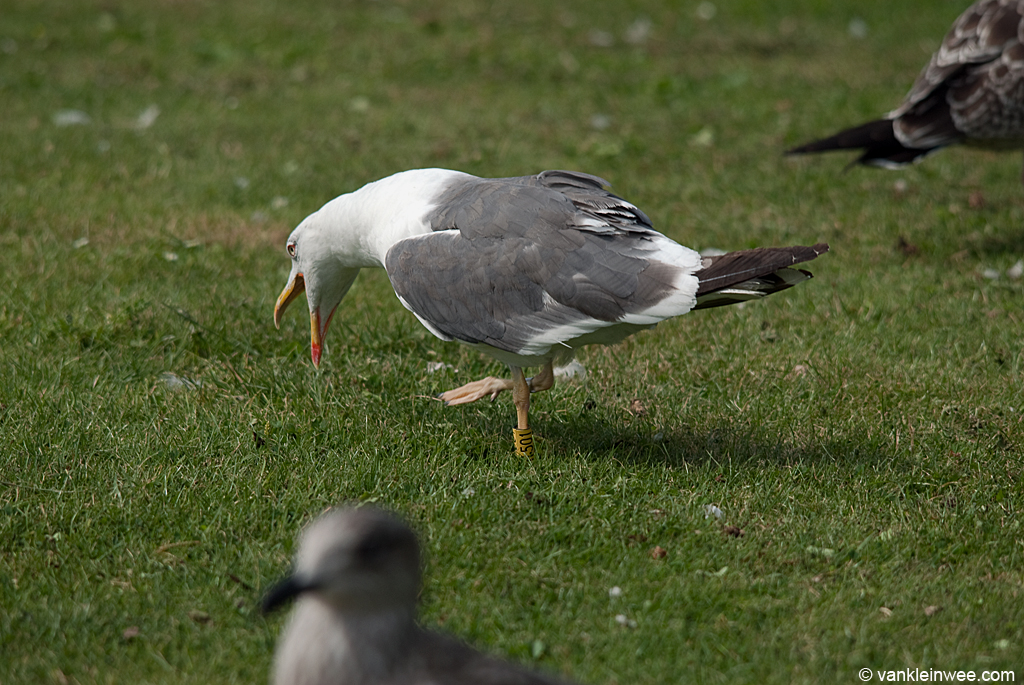
Adult Lesser Black-backed Gull Yellow H.501 performing the mew-call. Leiden, The Netherlands, 21 August 2012.
At first, it was by itself and it paused at times to tug at some blades of grass (a very light form of grass-pulling).
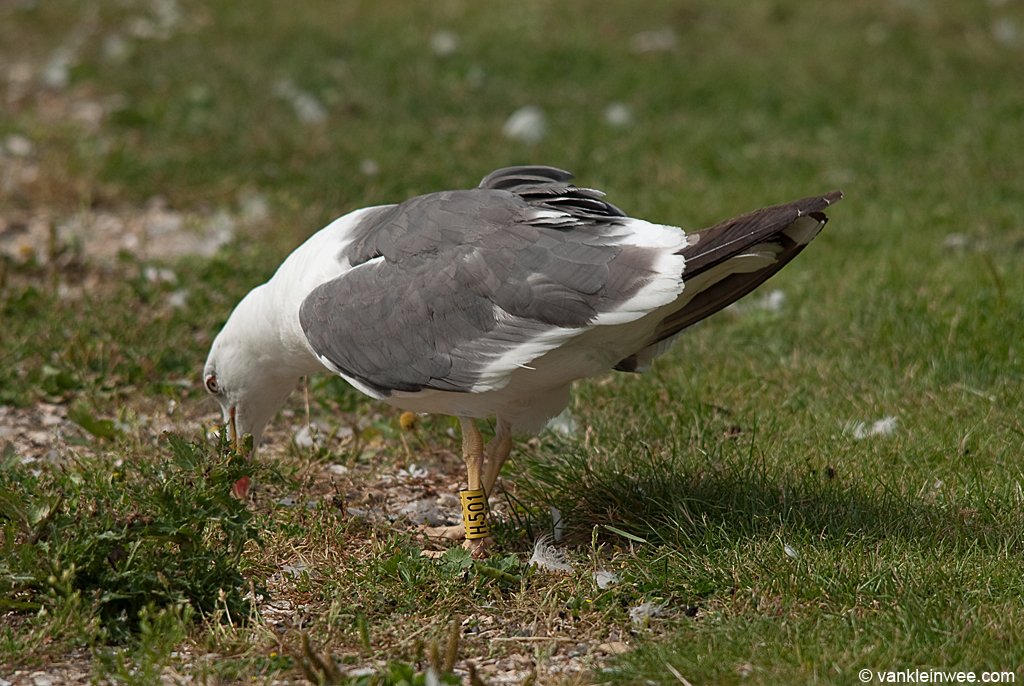
Adult Lesser Black-backed Gull Yellow H.501 tugging at the grass. Leiden, The Netherlands, 21 August 2012.
It then walked a short distance while mew-calling:
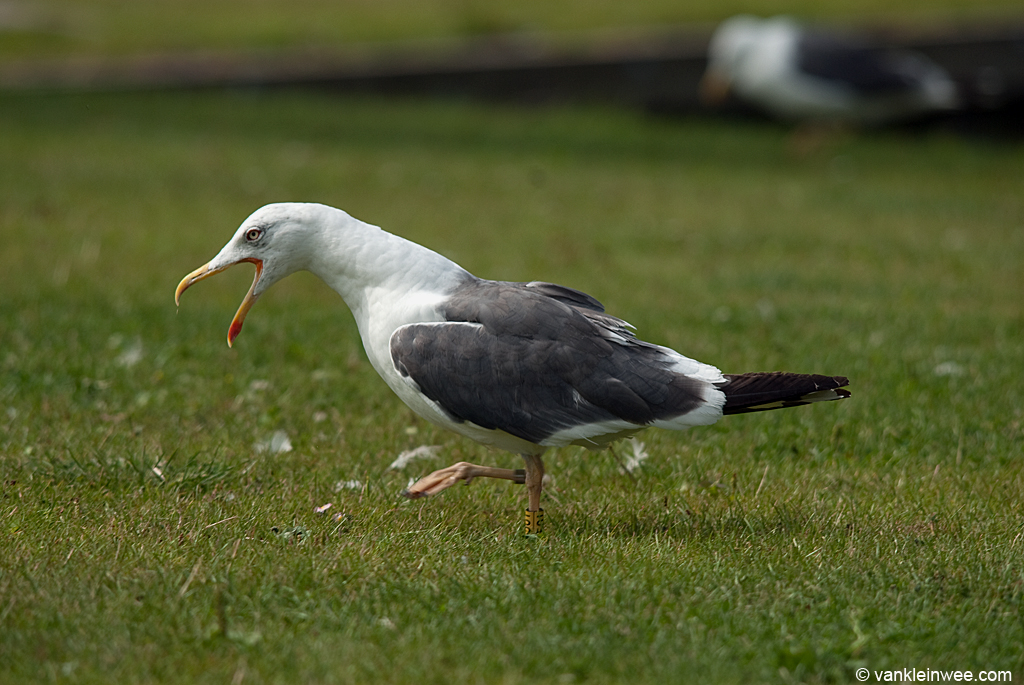
Adult Lesser Black-backed Gull Yellow H.501 performing the mew-call. Leiden, The Netherlands, 21 August 2012.
We then noticed that it was joined by a second adult, and they both started performing the long-call:

Adult Lesser Black-backed Gull Yellow H.501 performing the long-call together with an un-ringed adult.. Leiden, The Netherlands, 21 August 2012.
After walking together for a short distance, they were joined by a third adult.
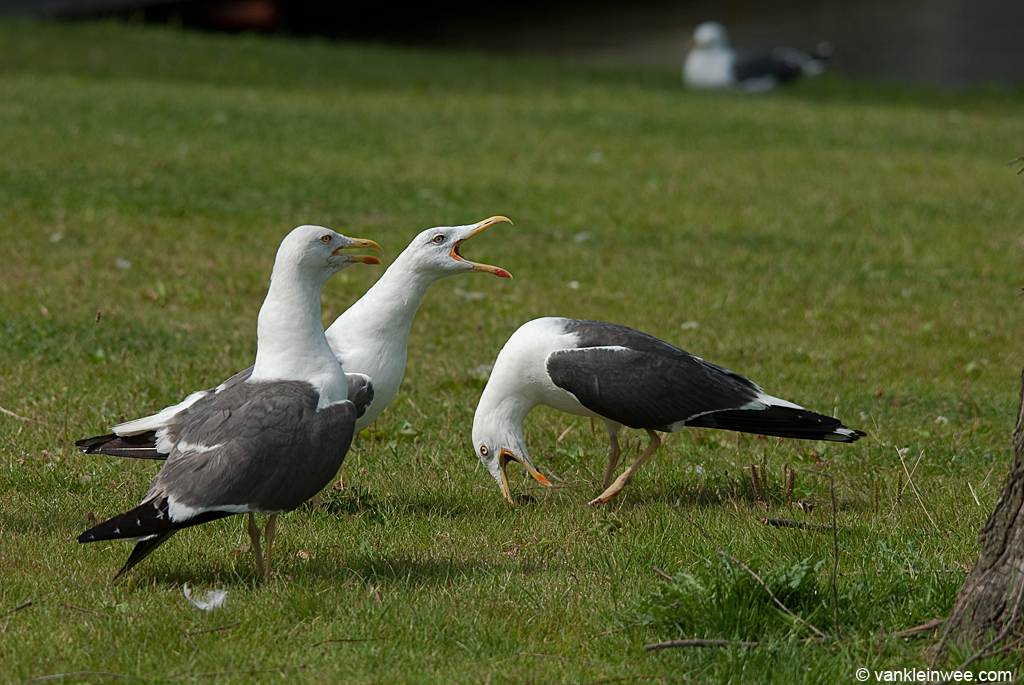
Adult Lesser Black-backed Gull Yellow H.501 (center) performing the long-call with one other un-ringed adult while another is mew-calling. Leiden, The Netherlands, 21 August 2012.
For more than a minute, the 3 of them performed long-calls, contact calls and mew-calls:
H.501 then walked off with one of them, and a whole ritual unfolded, consisting of walking parallel next to each other while mew-calling:
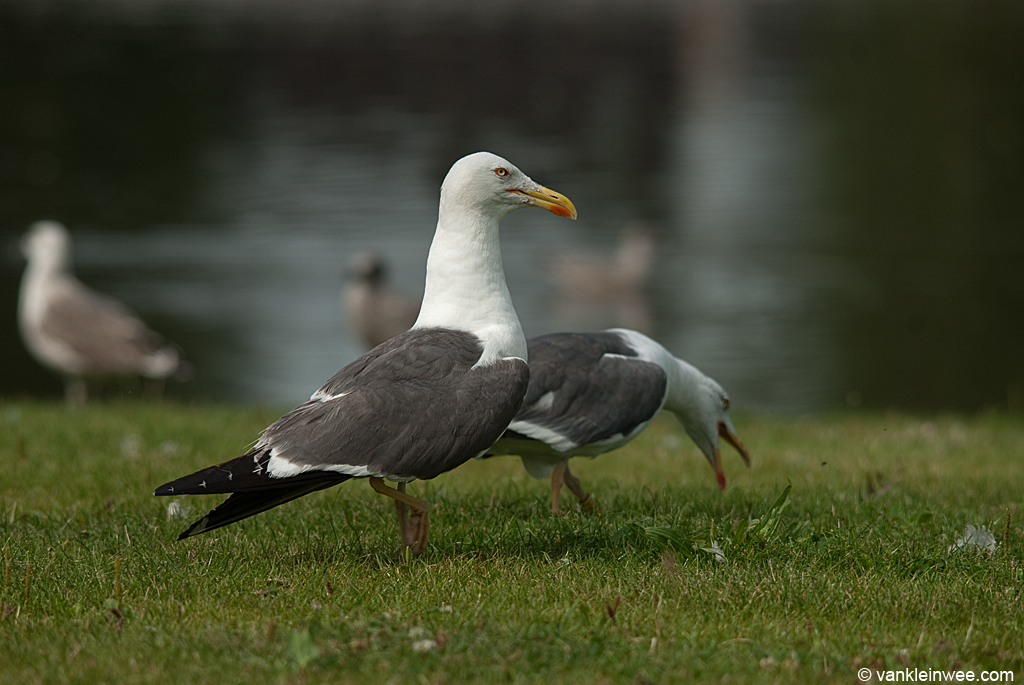
Adult Lesser Black-backed Gull Yellow H.501 (rear) performing the mew-call while the adult in front is in the upright posture. Leiden, The Netherlands, 21 August 2012.
…tugging at the grass:
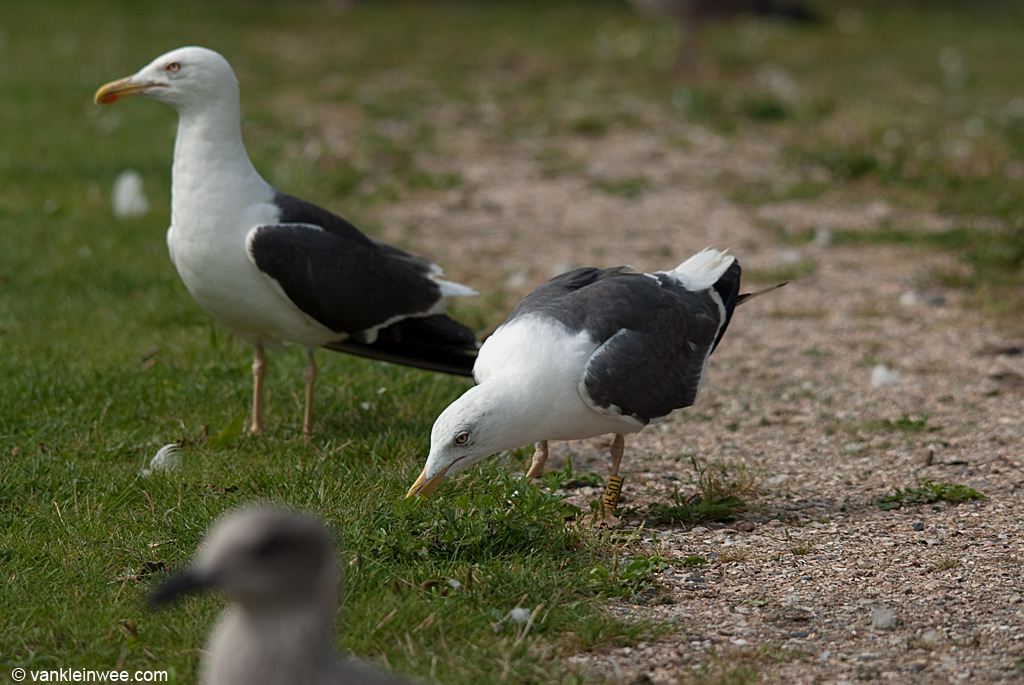
Adult Lesser Black-backed Gull Yellow H.501 tugging at the grass. Leiden, The Netherlands, 21 August 2012.
…sitting on the ground as if positioning on a nest:
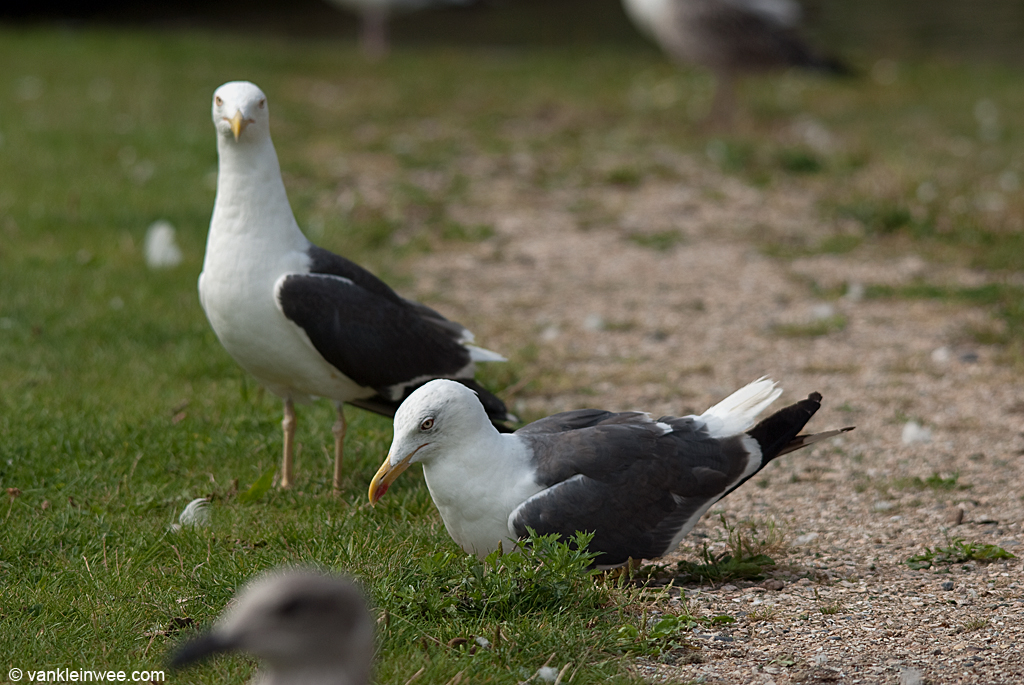
Adult Lesser Black-backed Gull Yellow H.501 (front) sitting down as if nesting. Leiden, The Netherlands, 21 August 2012.
…all the while clearly interacting with each other:

Adult Lesser Black-backed Gull Yellow H.501 interacting with un-ringed adult. Leiden, The Netherlands, 21 August 2012.
…more grass-tugging:
…as well as choking in a sitting-down position:
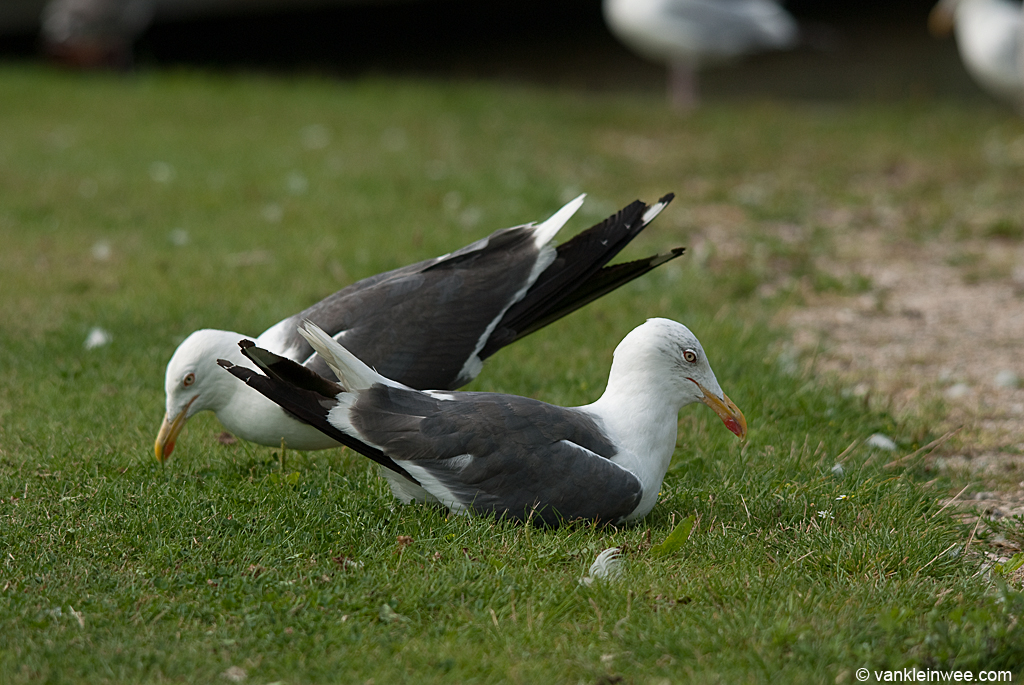
Adult Lesser Black-backed Gull Yellow H.501 (front) choking. Leiden, The Netherlands, 21 August 2012.
I was able to record the sound that is made during choking as well:
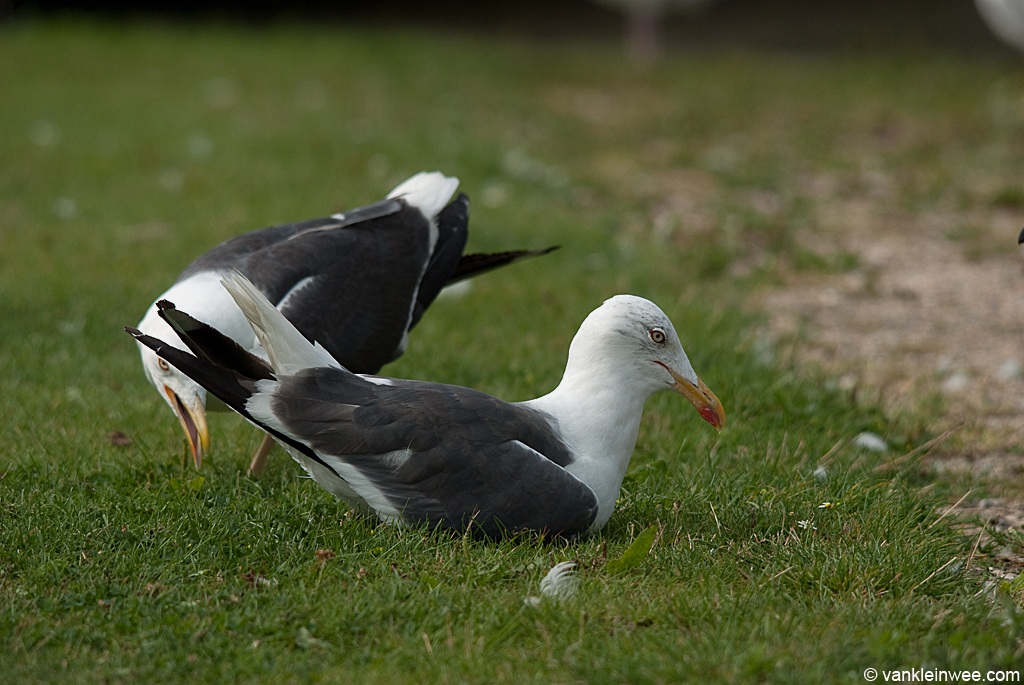
Adult Lesser Black-backed Gull Yellow H.501 (front) choking, while the adult behind it is grass-tugging. Leiden, The Netherlands, 21 August 2012.
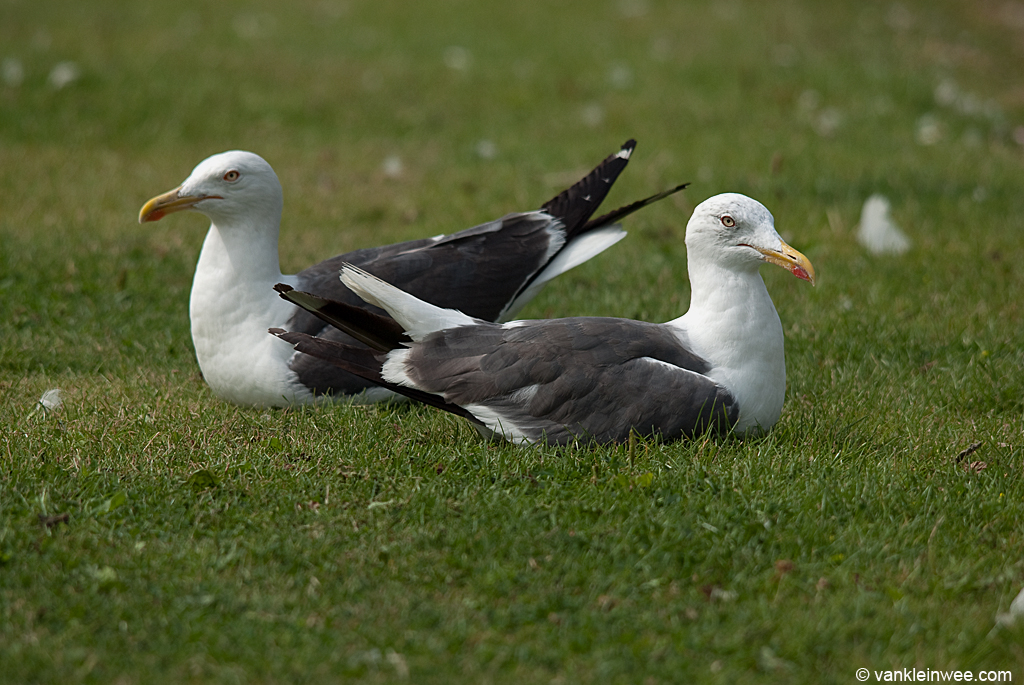
Adult Lesser Black-backed Gull Yellow H.501 (front) and un-ringed adult, sitting down as if nesting. Leiden, The Netherlands, 21 August 2012.
This whole process lasted about 5 minutes and took place just a few meters in front of us. It then repeated itself right up until we left and it possibly continued after that.

Adult Lesser Black-backed Gull Yellow H.501 (front) performing the mew-call while walking parallel with an un-ringed adult. Leiden, The Netherlands, 21 August 2012.
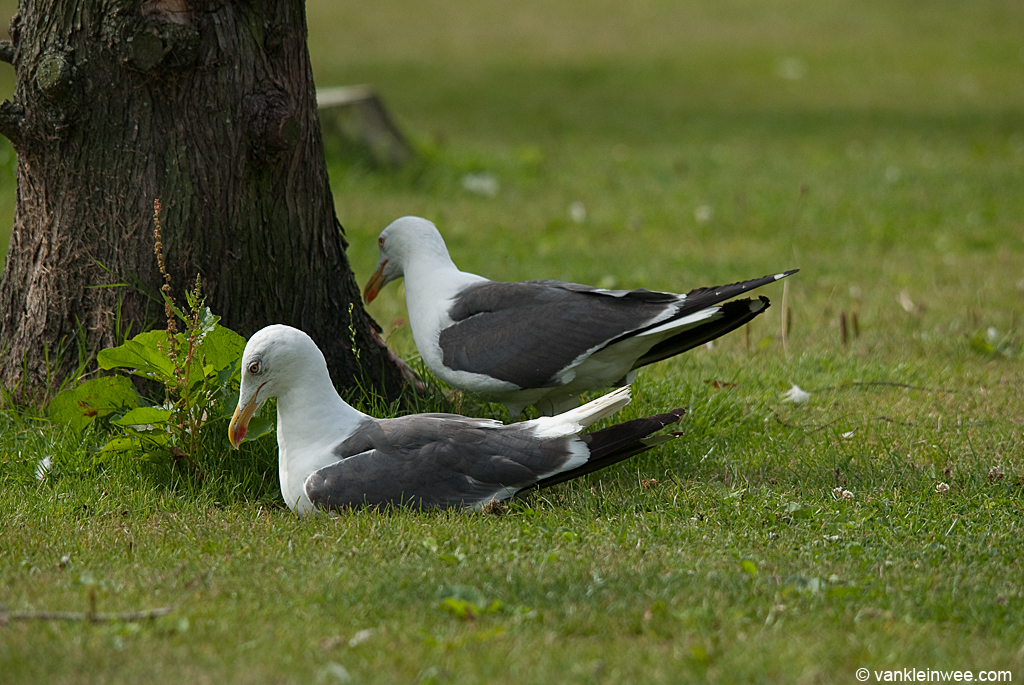
Adult Lesser Black-backed Gull Yellow H.501 (front) sitting down. Leiden, The Netherlands, 21 August 2012.
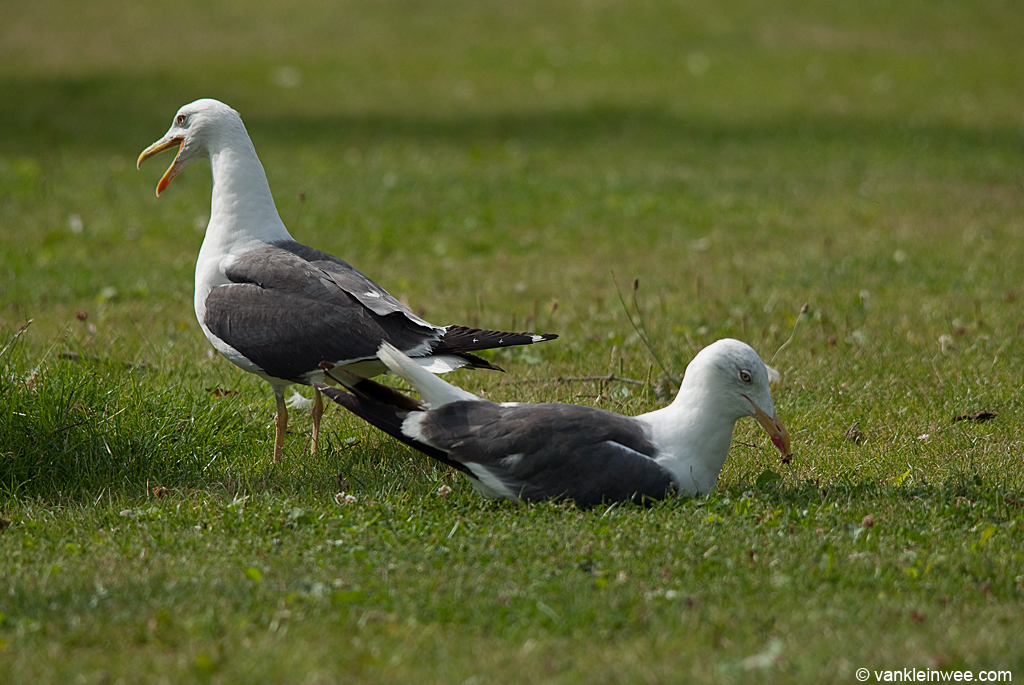
Adult Lesser Black-backed Gull Yellow H.501 (front) choking, with un-ringed adult performing the mew-call. Leiden, The Netherlands, 21 August 2012.
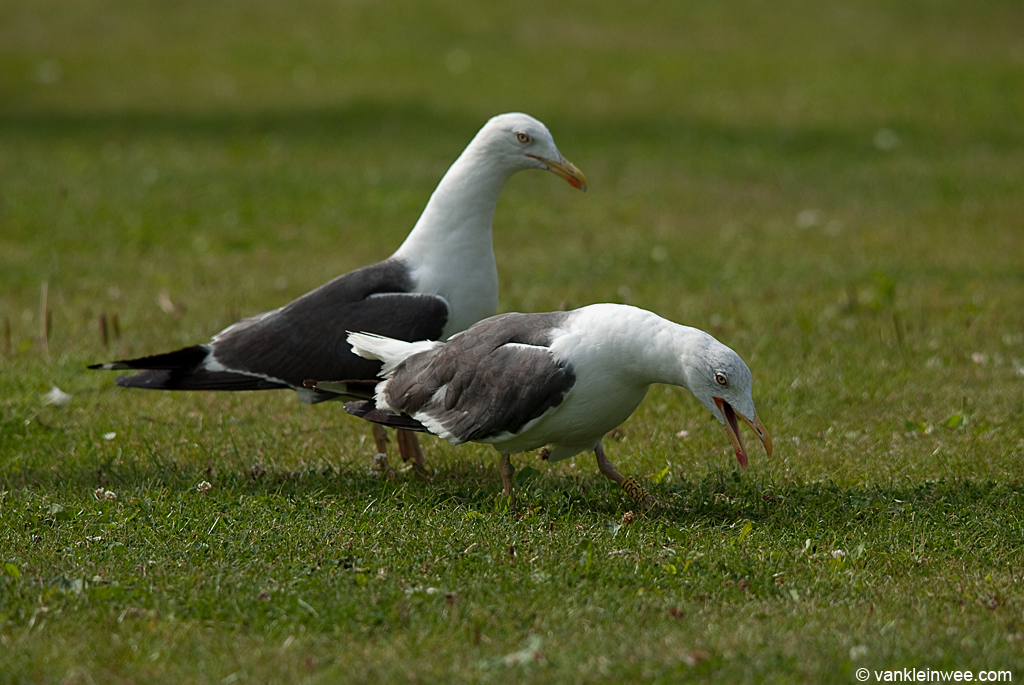
Adult Lesser Black-backed Gull Yellow H.501 (front) performing the mew-call, with un-ringed adult. Leiden, The Netherlands, 21 August 2012.
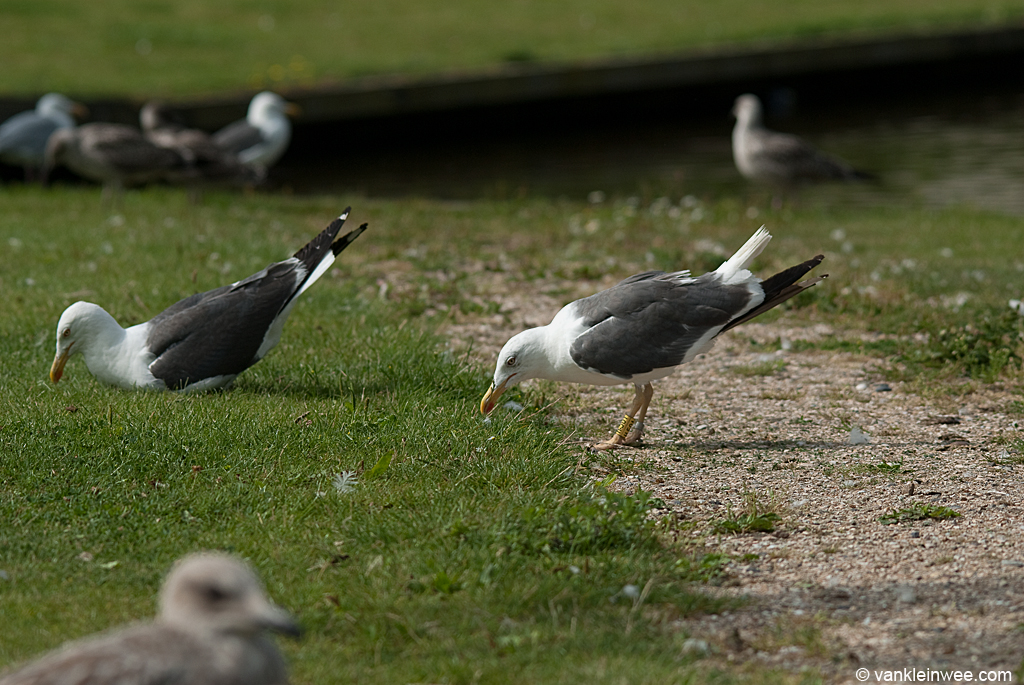
Adult Lesser Black-backed Gull Yellow H.501 (front) grass-tugging, with un-ringed adult choking. Leiden, The Netherlands, 21 August 2012.
On video
Jan Zorgdrager managed to capture part of this fascinating behavior on video:
Discussion
So what to conclude from this behavior? Is it pair-forming or something else?
Looking at both individuals in the field and while studying the images and video now, I find it hard to sex both gulls. At first I believed that both were males, but after having seen the video I’m tempted to say that H.501 is female and that the un-ringed individual is a male.
If it is not pair-forming than it could be aggressive behavior. Indicators are the wings that are raised from the flanks, the long-calling, mew-calling, grass-pulling and choking, which are all part of antagonistic behavior. Most of this behavior though can also occur between (future) mates.
The whole sequence though doesn’t come across as aggressive to me; there were no charges or raising of the wings as we are known to see in really aggressive encounters. The video clearly shows a tranquil atmosphere of two individuals trying to get to know each other rather than fighting each other. The choking as well did not come across as aggressive but more in line with showing each other a place suitable for nesting.
Niko Tinbergen in The Herring Gull’s World (1960) describes the male’s role in the initial pair forming and how the male gull performs the mew-call, walks with a female to a place nearby to make incomplete nest-building movements. Tinbergen also goes on to say that these movements are indistinguishable from hostile choking.
My knowledge and experience in reading this type of behavior is limited though and at this moment the jury is still out. I will contact some experts to get their take on it.
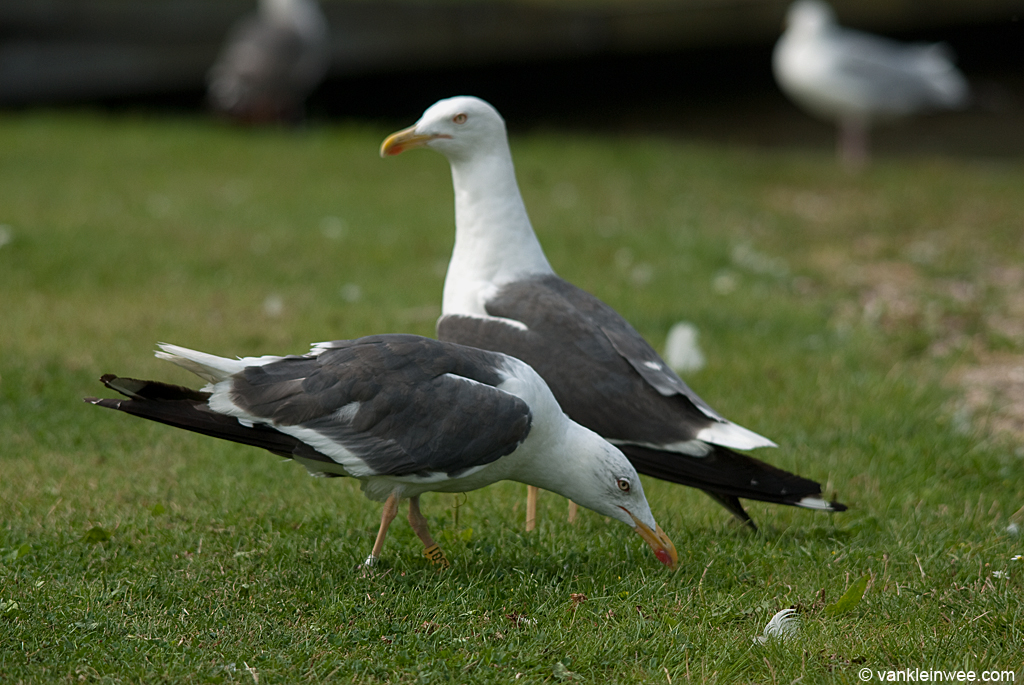
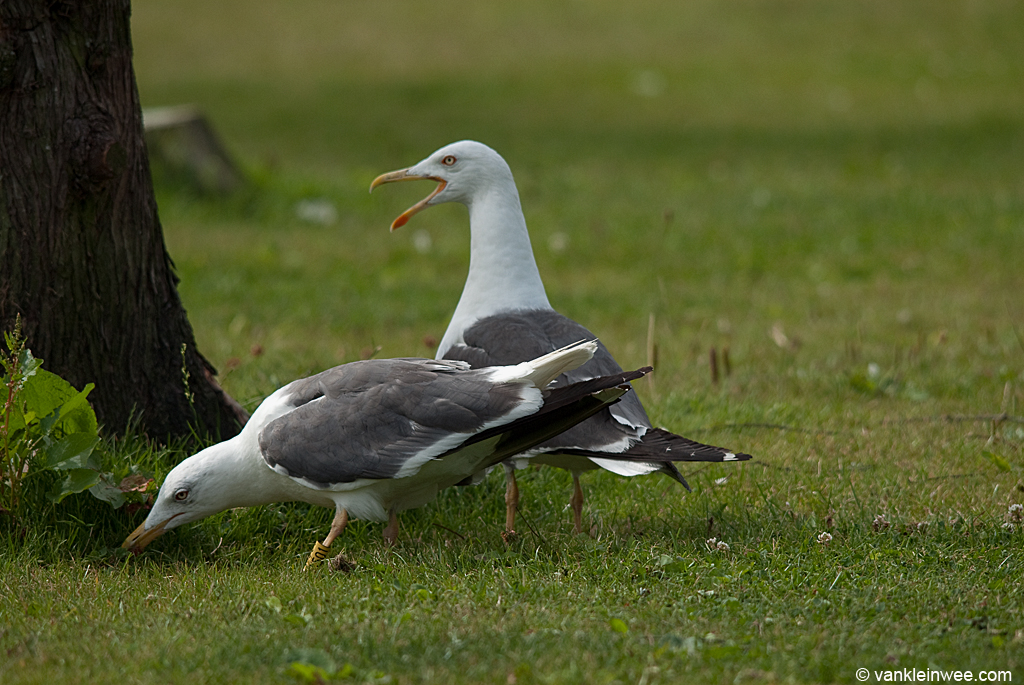
Update: after consulting various experienced Lesser Black-backed Gull & Herring Gull ringers (amongst which the ringer of Yellow H.501), the consensus now seems to be that both gulls were already paired and that they are reconfirming their bond away from the breeding grounds.
A very interesting suggestion which makes much more sense than treating it as a new bond that is being formed.
Pingback: Video Library: Large Gulls « Earbirding.com
end of July 2016:
My home office looks out on the flat roofs of two blocks of Leiden houses. From the beginning of summer a couple of lbb gulls have come to nest on the left roof and have now produced a clutch of 3 chicks and raised them to “flying lessons” age…
However, about a month ago a chickless couple (?) started arriving every evening on the right roof (they look quite adult). This has prompted standoffs every evening since then, when the hen (?) from the left roof flies over and attempts to stare down/peck at the two of them … until her mate arrives and chases both off or “breaks their moral” (that was the pattern the first few weeks, but now some sort of stalemate has arrived and there seems to be a grudged tollerance and the the newcomers now effectively “own” the right roof).
The reason I say “couple” is because this chickless interlopers on the right roof have been displaying precisely the bonding behaviour documented above . However, it appears to be a melange of pair-bonding and territorial behaviour (i.e. mews etc., but interchanged with long calls when the other lot are near and lots of “ga ga ga” frustration when they’ve lost a stare-down) – some of it (like the sudden sitting down) might even be interpreted as displacement perhaps. Territorial behaviour seems to prompt bonding and vice-versa and sometimes it melanges. I wish I could catch ’em and ring ’em, because it would be fascinating to see if they return next year and try to nest on their newly conquored territory…
thank you for the website (beautiful beasts, but noisy b*ggers though…)
Hi Alex,
Thanks for your interesting response.
Nice that you get to observe this interesting behaviour from up close!
As far as identifying them is concerned: you could try to take a photo of the wing pattern of each individual and use it to compare it with the wing patterns of the gulls on the roof of subsequent years. It would be interesting indeed to see if the same pairs are involved each year (or not).
Regards,
Maarten
Thanks Maarten,
Just got an opportunity to snap some photos of (what I think is) the male interloper (he was banging on my window, presumably in the hope I’d choke up food (I did this just once over 3 weeks ago – not a good idea – but they remember.. – or perhaps to fight his reflection???.)
I can recognise this one by his damaged bill in any case.. – am I correct that the brownish feathers mean he is still on the young side?
Also just seen something cool 2 secs ago on the _other roof_: selective chick feeding! (i.e. parent chases off 1 chick so as to have opportunity to feed the other – no idea if one or either was the “runt”….)
Aahooooh… wack wackwack wackwacka!
Alex
Observing the “right roof v. left roof”disputes, I have think I’ve seen the following – layered – system of teritorial “rights” in these lbbgs in respect to some very good “gull real estate”.. (high flat roofs, near open water, with an internal courtyard with foraging bonanzas (people throwing food at them)):
– Landing rights (defended with long calls and “standoffs”)
– Foraging rights (defended with long calls and violence)
– Nesting rights (?) (not sure what the defence of these is (prolly long calls plus ultraviolence) – but the main point is that nesting rights appear to give automatic “entitlement” to the accompanying landing and foraging rights…
– Gulls that win landing rights do not necessarily win foraging rights (these are protected by a higher level of violence)
– Even if landing rights are established, the owners of the prime right (nesting) will still spook the landers to let them know they are merely tolerated…. will traverse their space to stress them and let them know their place
– Will this pattern persist in a new season?
Hi Alex, apologies for the late reply. Just to answer your question in your previous reply: yes, the brown colouration indicates a sub-adult. Most probably a 4th-calendar year.